By Sarah Garlick and
Lindsey Rustad
August 11, 2020
Editor’s note: This article was originally printed by the Hubbard Brook Research Foundation. Re-published with permission.
Ice storms are extreme winter weather events that affect people and forests around the world. In the northeastern United States, where icing is common, major ice storms have the potential to reshape our forest ecosystems and the ecological attributes we rely on, including clean water, wood products, carbon storage, and natural areas for recreation and scenic beauty.
Scientists from the Hubbard Brook Ecosystem Study set out to understand more about how the forests of the Northeast respond to and recover from ice storms. As extreme weather increasingly becomes a hallmark of climate change, their research provides important insights for future forest management and storm response.
The Ice Storm Experiment at Hubbard Brook involved three efforts: (1) the first-ever experimental ice storms, conducted within controlled plots at a research forest, to understand and quantify the effects of different amounts of icing on hardwood forests; (2) synthesis of research related to the epic 1998 ice storm in New England to understand the long-term impacts of ice storms on forests; and (3) climate modeling to understand the frequency and intensity of ice storms under possible future climate change scenarios.
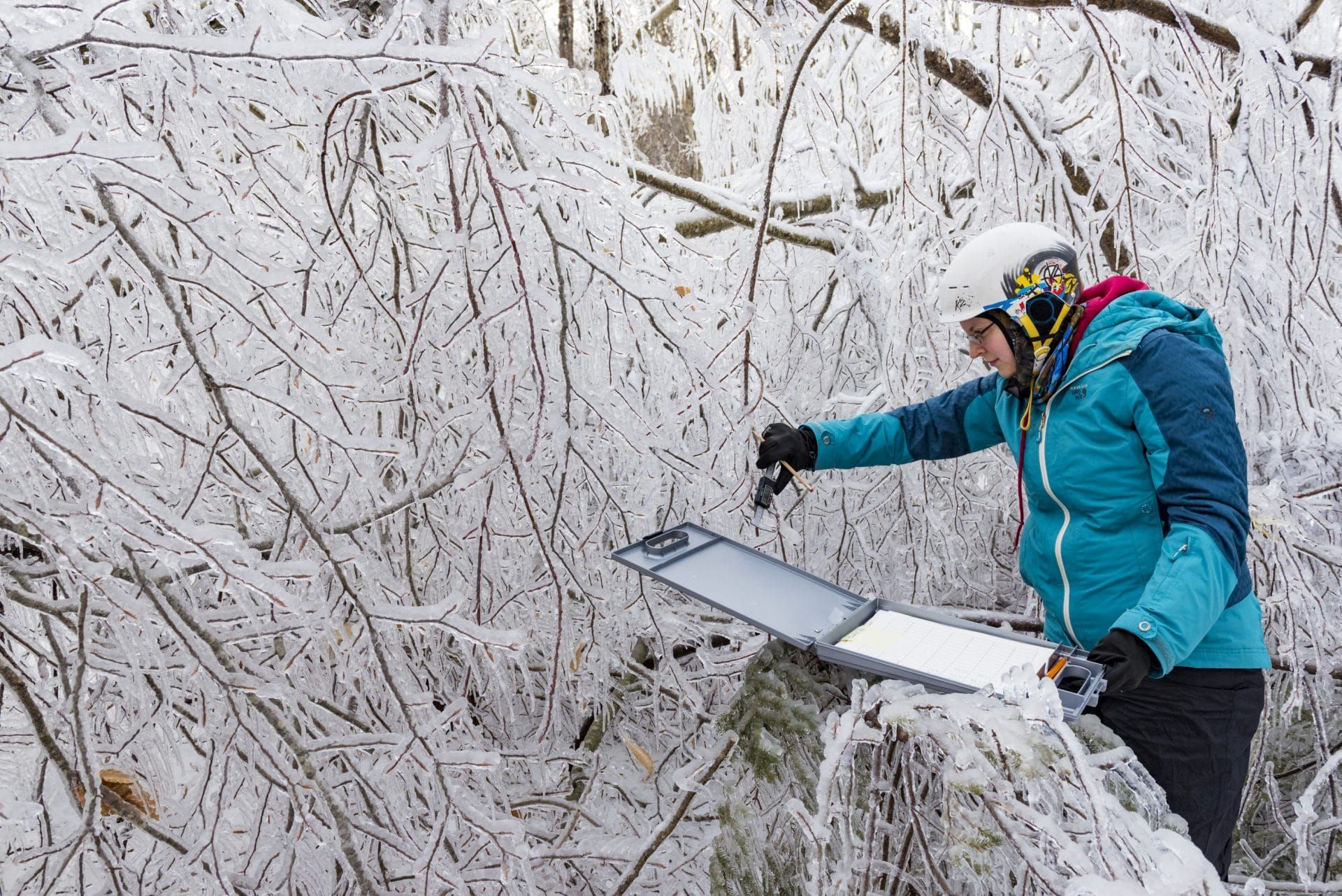
Student researcher Wendy Leuenberger measures ice accretion during an experimental ice storm. Photo by Joe Klementovich.
About the Experiment
During the winters of 2015–2016 and 2016–2017, scientists created the world’s first experimental ice storms in the Hubbard Brook Experimental Forest, a research site in New Hampshire’s White Mountain National Forest. Using pumps and fire hoses, the team sprayed the forest canopy with water from a nearby stream over several nights with sub-freezing temperatures. The water froze as it reached the trees and ground, coating the forest with ice, closely matching conditions during an actual ice storm. The team iced individual plots with ¼-inch, ½-inch, or ¾-inch ice, measured as radial ice accretion around branches. They repeated the treatments to some of the plots in 2017 to test the impacts of back-to-back storms.
In addition to the amount of ice, the team measured many variables in the forest, both before and after the icing treatments, to understand the effects of ice storms on forest structure and ecosystem functions. Measurements included changes in the forest canopy, the amount and timing of twig and branch fall, forest carbon and nitrogen cycling, tree physiology, and potential cascading impacts on forest animals, including beetles, birds, and bats.
Key results
- Future ice storms may become more severe. Climate models predict that under likely climate change scenarios, we will see the same number of ice storms as we do today, but more of these storms will fall into the class of large events similar to the 1998 storm.
- The Ice Storm Experiment identified a threshold at which ice begins to seriously damage trees. Tree damage was minimal up to about ¼-inch of ice. Then, with additional icing, large branches began to fall. Between ½- and ¾-inch, whole treetops began to snap under the weight of the ice.
- Ice storms change canopy structure. Experimental icing increased canopy openness, canopy complexity, and light transmission through the canopy to the forest floor. These changes were strongest with ice accretion levels of ½-inch or greater. Beech trees from the mid-canopy tended to bend rather than snap under ice accretion.
- The downed twigs and branches from a single ice storm can rival the annual input of woody debris that typically falls in a forest. During the experiment, under ½-inch of icing, the fallen branches, collected and weighed in the months following the treatment, equaled the average input of coarse woody debris in this forest over an entire year. Under ¾-inch of icing, the inputs of coarse woody debris were almost five times greater than the average annual inputs.
- Multiple ice storms in consecutive years can increase the amount of woody material reaching the ground. Two of the plots in the Ice Storm Experiment received ½-inch of icing in back-to-back years to understand the effects of consecutive storms. These repeated treatments showed that more woody debris fell from the forest canopy during the second year of icing than the first, suggesting that some branches damaged in the first year of icing remained in the canopy and fell to the ground during the second year.
- Icing causes large and irregular wounds to trees as the accumulating weight of ice snaps branches and strips them from tree trunks. Trees need to expend significant carbon reserves to heal these wounds and to produce defense chemicals to protect the tree from insect pests and pathogens. After two years, trees showed surprisingly little wound closure, suggesting they would be susceptible to secondary infections.
- Forest responses to ice storms may be changing. The Ice Storm of 1998 caused a spiked increase in the nitrogen concentrations in stream water and in water in soils at Hubbard Brook. In contrast, the experimental ice treatments showed no nitrogen effects. This difference may be due to the size of the experiment or may be an indicator of a fundamental change in this ecosystem from being nitrogen-rich in the 1990s to nitrogen-poor in recent years. The retention of nitrogen, an important nutrient for forest growth and a potential pollutant downstream, is an area of active research at Hubbard Brook. Lower mobilization of nitrogen following a disturbance like an ice storm conserves an important nutrient resource, but may slow forest recovery.
- New England forests are still recovering from the Ice Storm of 1998. Research shows that, across the region, different forest stands and tree species experienced different amounts of damage. In general, younger stands, approximately 14 years old, experienced little damage; mid-successional stands, about 24–to-28 years old, dominated by pin cherry, experienced intense damage; and older stands, roughly 60–to-120 years old, experienced significant damage. In the older stands, damage was greatest in American beech, followed by yellow birch, followed by sugar maple. In general, conifers fared better than hardwoods. Trees with advanced beech bark disease experienced heavier damage; trees with deep, healthy root systems and trees that lost less than half their crown during the storm mostly survived.
- At Hubbard Brook, the Ice Storm of 1998 disturbed many attributes of the ecosystem, from the soils and streams to the canopy. The 1998 ice storm coated mid- to higher-elevation forests at Hubbard Brook with ¼-to-½ inch of ice. Research showed an approximate 33-percent decrease in forest canopy cover, damage to fine roots, and increases in soil and stream water nitrogen concentrations in the three years following the storm. Longer-term impacts on canopy structure, regeneration, and species composition were still apparent at Hubbard Brook up to eight years later.
- Research from the Ice Storm Experiment has helped weather observers create a standardized way to measure ice accretion. Ice accretion can be difficult to measure. The Ice Storm Experiment showed that radial ice accretion measured with calipers tended to underestimate ice accretion when icicles were present. Further work, undertaken with a team of meteorologists and weather observers to develop a universal, low-cost ice collector, showed that using ¾-to-1¼ inch rods made from common materials such as wood or PVC installed at a 30 degree incline reduced icicle formation and offered relatively high precision for measuring accumulating ice.
Why this matters
The Ice Storm Experiment at Hubbard Brook provides the first quantitative measurements of twigs and branches falling from forest canopies to the forest floor in response to different intensities and frequencies of ice accumulation. These metrics can help foresters, emergency managers, town planners, electric power utilities, arborists, winter recreationists, and others be better prepared for the aftermath of ice storms.
Results from the experiment suggest that mature northern hardwood forests will sustain little damage below ¼-inch of radial ice accretion, moderate damage with up to ½-inch of accretion, and potentially catastrophic damage with upwards of ¾-inches of ice or more. Based on these results, current ice storm warnings that are issued by the National Weather Service in New York and New England for about ½-inch or more of radial ice accretion may be too high because significant forest effects, including branch-fall, will have already occurred or be underway. The ¼-inch ice storm warnings issued for the Mid-Atlantic states may provide a safer level to alert the public about pending tree damage from ice storms.
Results from this experiment also suggest that first responders and forest managers need to be prepared for an equal or greater amount of woody debris falling from the canopy if large storms occur in back-to-back years. In this experiment, damaged branches that did not fall in the first year were more susceptible to further damage in an ensuing year.
More about ice storms
In New England, extreme ice storms have occurred about every 35–to-85 years, moderate ice storms have occurred about every 5-to-10 years, and light icing occurs every winter. Across the United States, ice storms account for roughly 60 percent of winter storm economic losses. They have caused more than $16 billion in insured property losses between 1949 and 2000. During severe ice storms, schools, businesses, and other services close. Slick roads and walkways, and carbon monoxide from unvented heating devices lead to injury and even deaths.
Ice storms can form anywhere where the conditions are right. They are common in an ice storm “belt” that extends from Texas to New England, as well as the Midwest, and mountainous regions of the Pacific Northwest.
Ice storms form when an upper layer of moisture-rich warm air overrides a ground layer of sub-freezing air. Precipitation falls from the upper layer as rain, supercools as it falls through the lower layer, and freezes as it contacts cold surfaces.
About the project and team
Funding for this research was provided by the National Science Foundation (NSF) under Grant No. 1457675. Any opinions, findings, and conclusions or recommendations expressed in this material are those of the authors and do not necessarily reflect the views of NSF.
Principal Investigators: Charles Driscoll, Syracuse University; Lindsey Rustad, U.S. Forest Service; John Campbell, U.S. Forest Service; Paul Schaberg, U.S. Forest Service; Katharine Hayhoe, Texas Tech University; Sarah Garlick, Hubbard Brook Research Foundation.
Research Partners: Peter Groffman, City University of New York and Cary Institute of Ecosystem Studies; Timothy Fahey, Cornell University; Robert Stanford, University of Southern Maine
Field Crew: Ian Halm, Frank Bowles, Geoff Schwaner, Gabe Winant, Brendan Leonardi, and many others!
Photography: Joe Klementovich; Video: Jim Surette
PDF version of this Research Brief, including references
More information about the Ice Storm Experiment and links to publications
Keywords: Hubbard Brook, climate change, climate crisis, experimental forest, extreme weather, global warming, ice storms
Topics: Climate Change
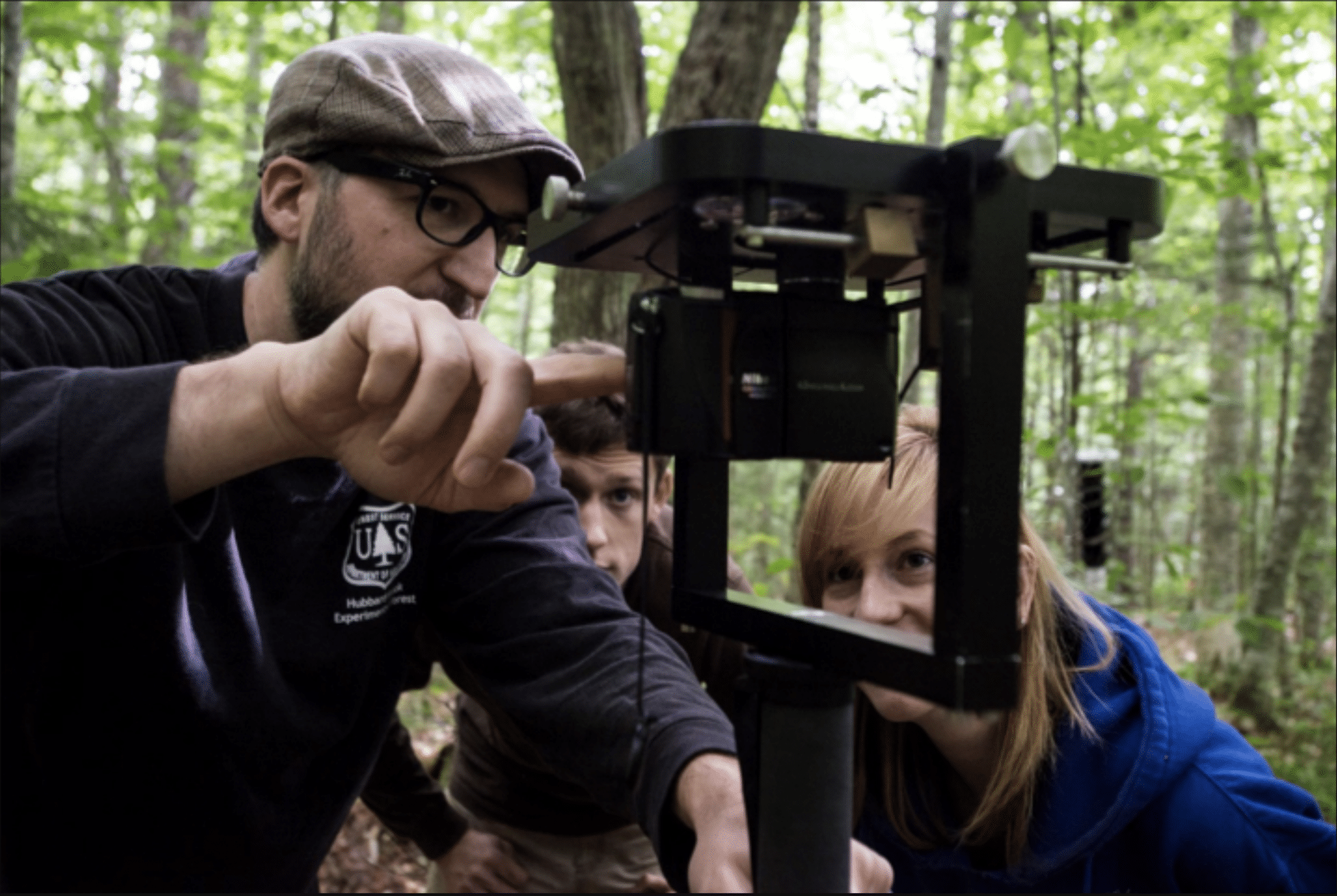
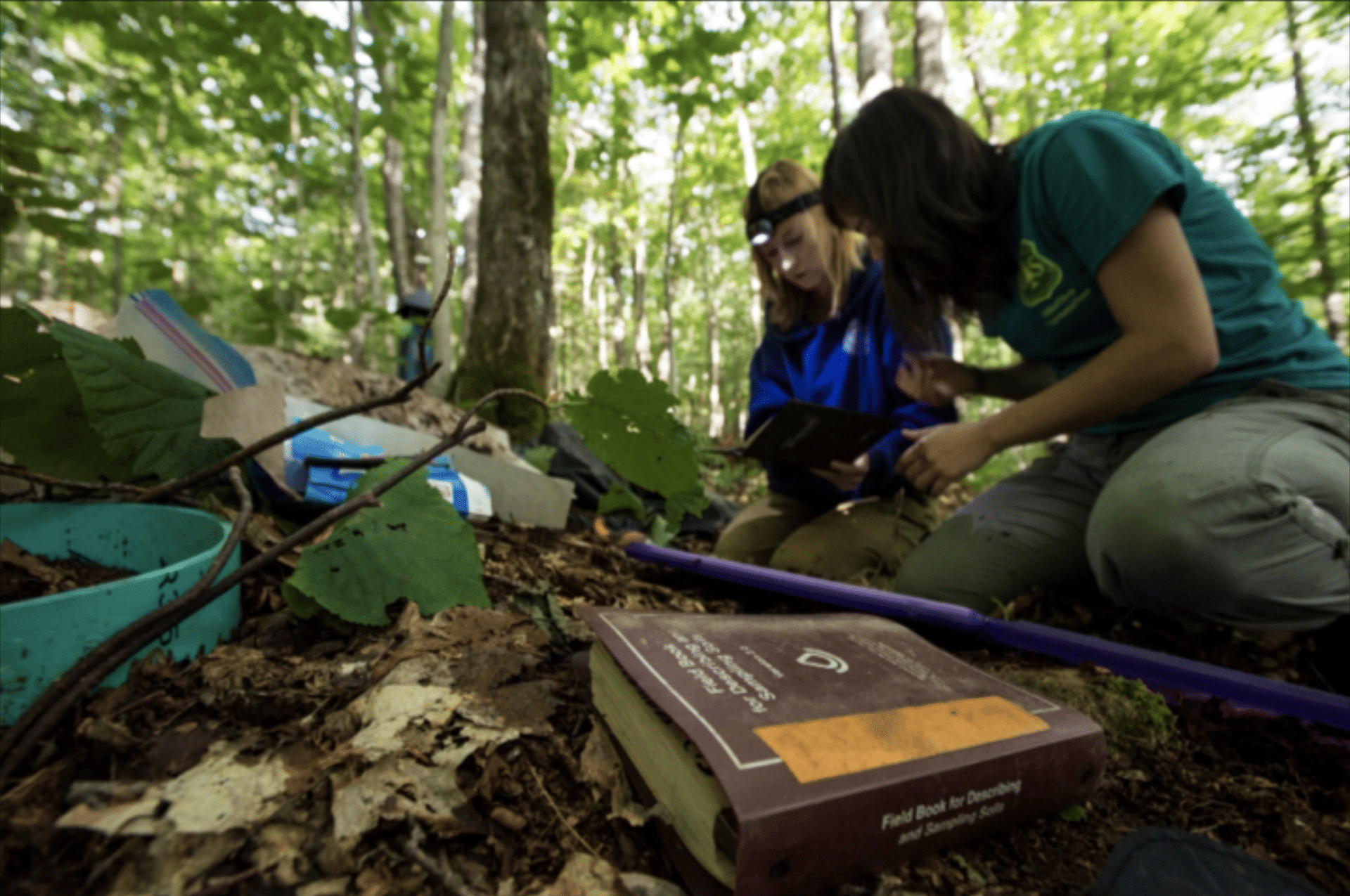
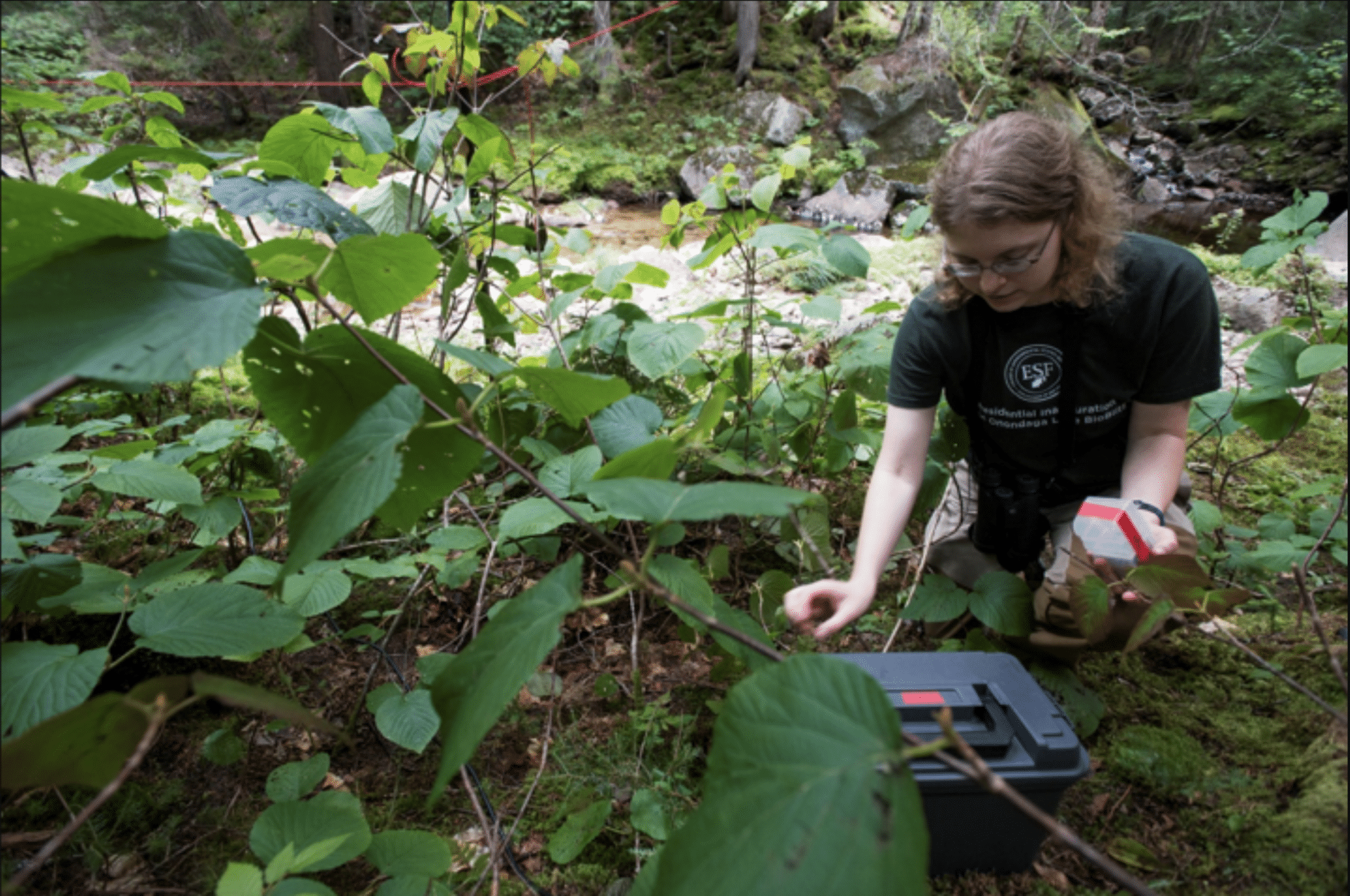
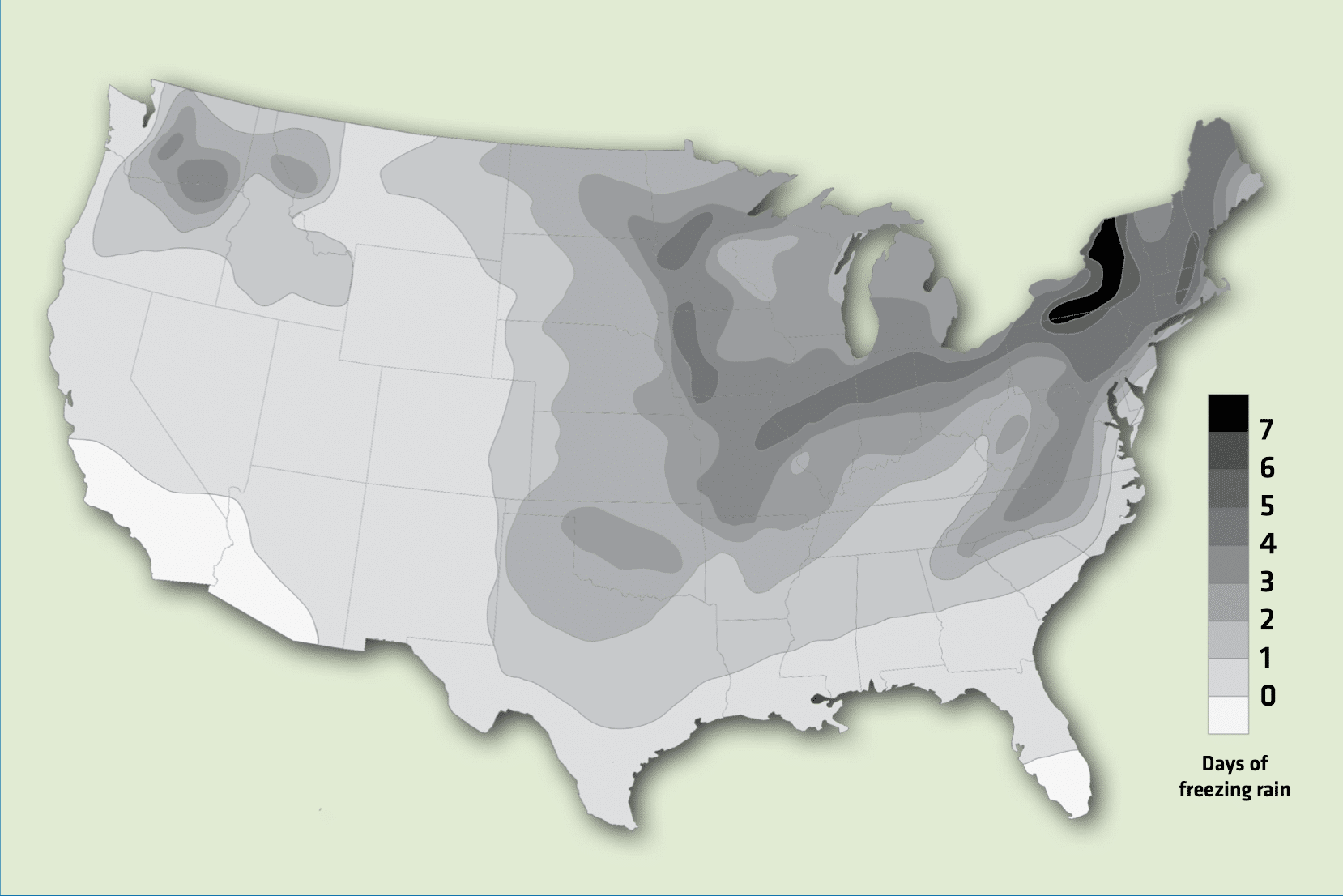
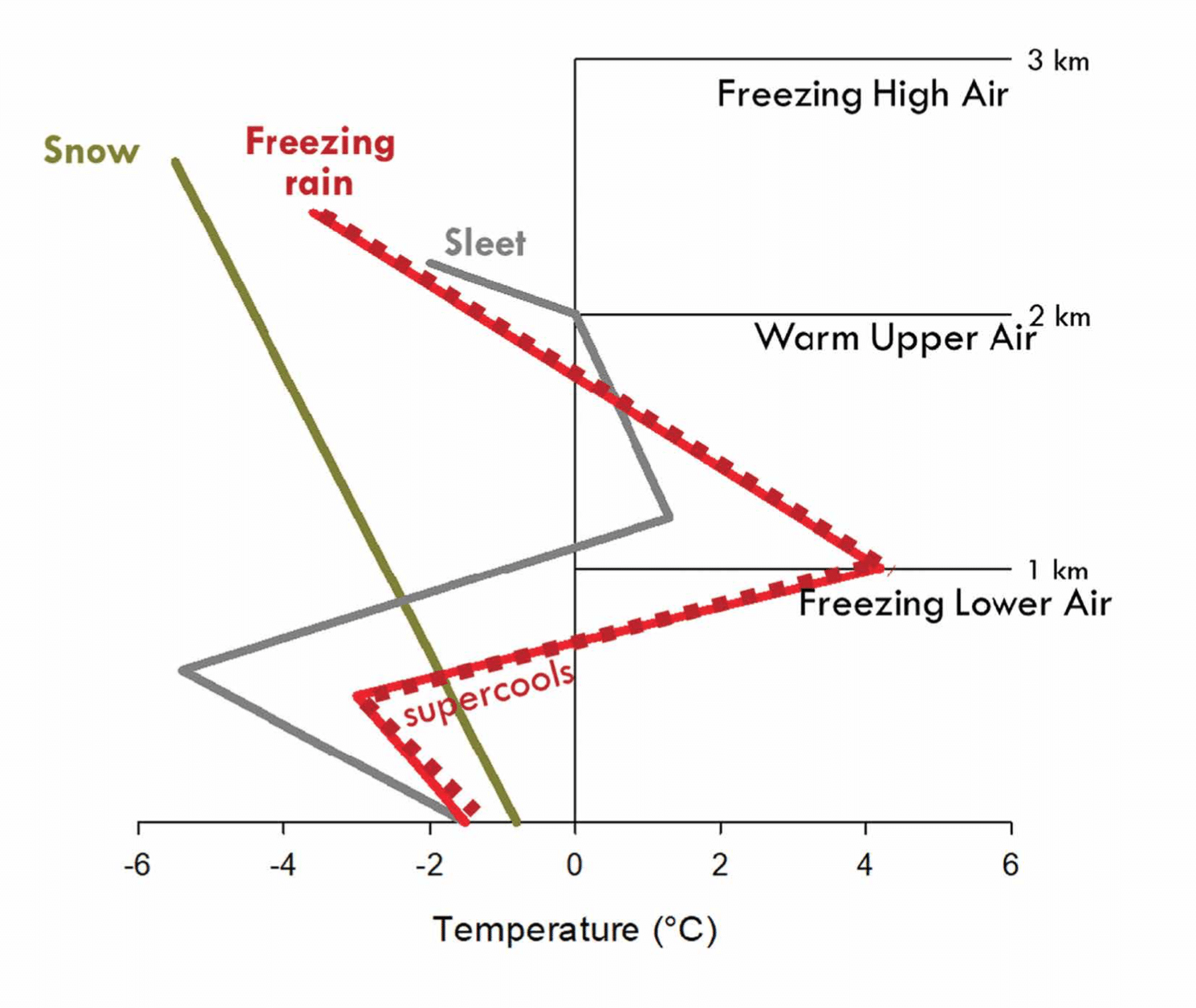








Due to climate changes of last decade or more, our winters here in Midwest have lacked the consistent cold, snow or precipitation needed for natural ice formations outdoors. As eager ice climbers, we ‘adjusted’ our needs by doing much the same process as at Hubbard Brook. Since about 2011, we have been freezing an old 40′ farm silo on coldest nights with water sprayers and soakers, to build a ‘tower’ with layers up to a foot per day, and finally growing up to 7 ft. thick at the base. Lots of work, but served our purpose for adventure.
Trying to recall what year it was, back in mid to late 90’s here near Chicago. Early fall ice storm caught trees with most leaves still on them. I was sleeping out in tent and could hear the ‘BANG’ ,over and over of my maple forest saplings being bent over in half and then snapping the trunks. Destroyed about 8 of them across a 50 ft. stretch of back yard. Can’t believe how fast that ice can build up on branches with such weight.